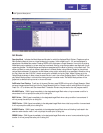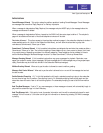
Operating Mode
Indicates the Mode Name and Number for which the displayed Block Pointers' Targets are active. Each Operating
Mode is given a unique Number by the system. Valid numbers are 01 - 99, and are assigned in sequence as new
Modes are created. Pressing ENTER at this field, opens a Pointer Mode Target Generator, from which an existing
Mode Name may be selected, or a new name may be entered. Entering a new name creates a new Mode with its cor-
responding Number. The Mode Number and Name are associated with the Block's Pointers, not the Block itself. This
allows each Block to route calls to different destinations in different Modes, using different Targets for the pointers'
various Mode references.
For example, the No-Answer pointer might route callers to an associate's Extension during the 'Day' Mode, but after
5:00 PM, it would route them to a Mailbox during 'Night' Mode. Pointers set in the Default Mode are always in effect
unless the same Pointer is set in the current Operating Mode. SVMi-8 will display Default Mode pointers in a block
while viewing pointers in another mode. The Default Mode pointers will be grayed out to denote that they are not in
the current mode.
CallDirector Event Pointers
To edit any Event Pointer, press ENTER to bring up the Target Generator. Highlight and open the appropriate Block
type. Select a new or existing Block and press ENTER. Press ‘Ctrl + O' to review or edit the Block.
MSG-LEFT Pointer This is the Block that the SVMi-8 will pass control to if the caller leaves a message. The target
block allows the caller the option of returning to the beginning of the application, or may send the caller to the Bye
block, if the organization does not want to give the caller additional options.
NOMSG-LEFT Pointer This is the Block that the SVMi-8 will pass control to if the caller does not leave a message.
The target block may allow the caller the option of returning to the beginning of the application, or sending the caller
to the Bye block if the organization does not want to give the caller additional options.
ESCAPE Pointer This is the Block that the SVMi-8 will pass control to if the caller presses the escape digit while
listening to the List greeting or while leaving a message. When the Escape digit is pressed the SVMi-8 will immedi-
ately exit the process it's in and go to the block defined in this pointer.
GREET-DTMF Pointer This is the Block that the SVMi-8 will pass control to if the caller enters any valid DTMF
while listening to the List greeting. If defined, the Admin digit, escape digit, digit to skip the greeting, and the opera-
tor digit are not considered valid for this pointer. The target block is a menu. The menu will perform a search opera-
tion to match the caller ENTRY to the INPUT value of a pointer, or Number of an Extension, Mailbox or
Announcement.
Operator This is the Block to go to if Operator assistance is requested.
Block Types and Descriptions
60


















